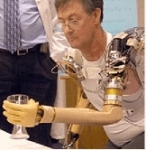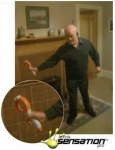Jun 29, 2005
Bionic Arm Technology is advancing
From Medgadget
Mr. Jesse Sullivan is the world's first "Bionic Man", according to the Rehabilitation Institute of Chicago (RIC). In May 2001, Mr. Sullivan lost both of his upper extremities as a result of an accident. The technology that allows this patient to control his artificial arms has been developed by RIC's Neural Engineering Center for Artificial Limbs (NECAL).
Developed within the Neural Engineering Center for Artificial Limbs (NECAL) at RIC, Dr. Todd Kuiken, MD, PhD, pioneered the muscle reinnervation procedure which takes an amputee's own nerves and connects them to a healthy muscle. In this case, four of Mr. Sullivan's nerves were dissected from the shoulder and transferred to the muscles of his chest. Doing so allows the user to move his or her prosthetic arm as if it were a real limb--by simply thinking about what they want the arm to do. The "Bionic Arm," or myoelectric arm, is driven using electrical signals from the muscles of the chest, now activated by the user's own thought-generated nerve impulses. These impulses are sensed, via surface electrodes, from the pectoral muscle and carried through to the mechanical arm, causing the arm to move.

NECAL uses nerve-muscle grafts in amputees to gain added control signals for an artificial arm. Doctors take nerves that used to go to the arm and move those nerves onto chest muscles. The nerves grow into the chest muscles, so when the patient thinks "close hand," a portion of his chest muscle contracts and electrodes that detect this muscle activity tell the computerized arm when to close the hand. Thus, the patient thinks "close hand" and his artificial hand closes...
Researchers at RIC have learned that although the limb is lost with an amputation, the control signals to that limb remain accessible in the residual peripheral nerves. Grafting the residual nerves of an upper-limb amputee to spare muscles produces additional control signals, allowing for simultaneous operation of multiple functions in an externally powered prosthesis with a more natural feel than is possible with conventional prostheses.
The "Bionic Arm" technology has been very successful so far in both significantly improving the function of artificial limbs as well as allowing the skin to be reinnervated with nerves form the arm. The first patient to undergo the new procedure, Jesse Sullivan, has experienced significant improvements in the functioning of his prosthetic arms. While previously moving his artificial arms was slow and cumbersome, today he is able to do many of the routine tasks he took for granted before his accident, including putting on socks, shaving, eating dinner, taking out the garbage, carrying groceries and vacuuming.
18:35 Posted in Brain-computer interface | Permalink | Comments (0) | Tags: brain-computer interface
Jun 27, 2005
Tennis for the visually impaired
From Near near future
Tennis Sensation is a tennis game that allows a wide variety of users, particularly the visually impaired, to compete fairly.

It uses spatial (3D) audio, to represent sounds at locations in space, enabling the user to locate the virtual ball. The handle of the "racquet" shows correct orientation and grip through contours and materials.
Skill and physical ability can be altered to allow use by the elderly and disabled. A handicapping level selection enables a grandparent to play with their grandchild. The game can be played by people in different locations. When gripped from the charger the product turns on and connects to the headphones automatically. It can connect through an internet connection or use the 3G phone network. Menus are navigated by tilting and options selected by squeezing the grip. Vibropads in the grip give the subtle vibrations associated with good and bad tennis shots, and haptics give the feel of a ball on the racquet at virtual impact. Banks of LEDs explode on impact, with colour representing the quality of the shot. A dedicated synthesiser generates the stereo sound and audio cues, and a Motorola RISC microprocessor performs the calculations.
13:15 Posted in Brain training & cognitive enhancement | Permalink | Comments (0) | Tags: Positive Technology, Cognitive prosthetics
Jun 21, 2005
As time goes by - New Memory Aid Helps Dementia Sufferers
Press release - Engineering and Physical Sciences Research Council (EPSRC)
PN: 14/05
Issue date: 15 June 2005
Classic movies such as ‘Casablanca’ could bring back lost memories for dementia sufferers thanks to an innovative memory aid.
Ladies Sweeping
The CIRCA system provides old photographs, video footage and music to help dementia sufferers remember the past and engage in conversation with their carers
Based on an interactive multimedia computer system and a clearer understanding of how dementia sufferers respond to social situations, the aid aims to stimulate more enjoyable, rewarding conversation between sufferers and those who care for them.
With funding from the Engineering and Physical Sciences Research Council (EPSRC), a team of researchers in Scotland has developed CIRCA (Computer Interactive Reminiscence and Conversation Aid). CIRCA comprises a simple touch-screen with easy-to-follow instructions that require no IT competence.

When switched on, it displays a choice of three random categories (entertainment, local life etc). Selecting a category, the user is given a choice of ‘music’, ‘photo’ or ‘video’. These in turn call up images, video or sound clips (e.g. of well-known movie stars such as Humphrey Bogart) from a database, acting as a memory trigger and conversation prompt. A ‘stop and talk’ button allows the system to be frozen at any point.
The research team has built a range of innovative features into the way the system is used. Because sufferer and carer sit side by side in front of the screen, encouraging the sense of a shared experience, and because the system relies on a touch screen, rather
Radio
While the current system draws on images and sounds from the 1930's to the 1960's the content could be tailored to reflect the sort of material likely to appeal to any age group
than a mouse or keyboard, the carer is not seen as being ‘in control’. Furthermore, as the sufferer can be prompted to operate the system themselves, they feel less dependent on their carer. The result is a more positive, relaxed social experience than can be achieved using other memory-prompting reminiscence packages currently available.
During development, CIRCA was tested on 40 dementia sufferers in daycare, nursing home and family situations. The results were very encouraging, with many carers reporting that sufferers seemed like their ‘old self’ (see case studies below). CIRCA exploits the fact that, while dementia sufferers find it hard to recall recent events, longer-term memory is less affected by their condition.
CIRCA could become available on the market in 2-3 years. The research team is now looking at whether it could also be used for people with learning disabilities or head injuries. In addition, they have secured EPSRC funding to develop an interactive multimedia activity system that dementia sufferers can use on their own.
Dr Arlene Astell of the University of St Andrews School of Psychology is leading the research team. Dr Astell says: "Dementia sufferers’ declining ability to hold normal conversations causes a lot of stress and frustration. Helping them access their memories will make living with dementia more bearable and less distressing for sufferers and their carers.”
00:00 Posted in Brain training & cognitive enhancement | Permalink | Comments (0) | Tags: Cognitive prosthetics






